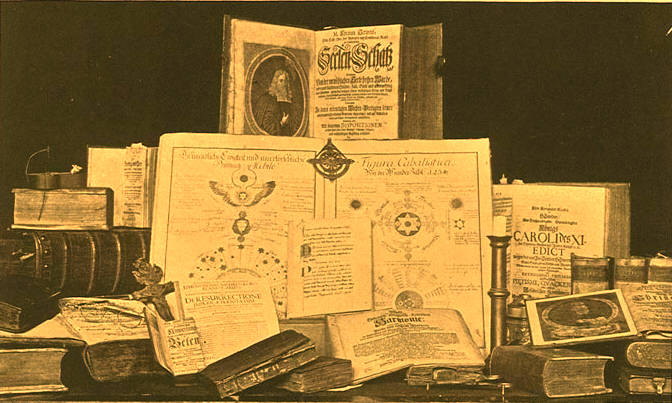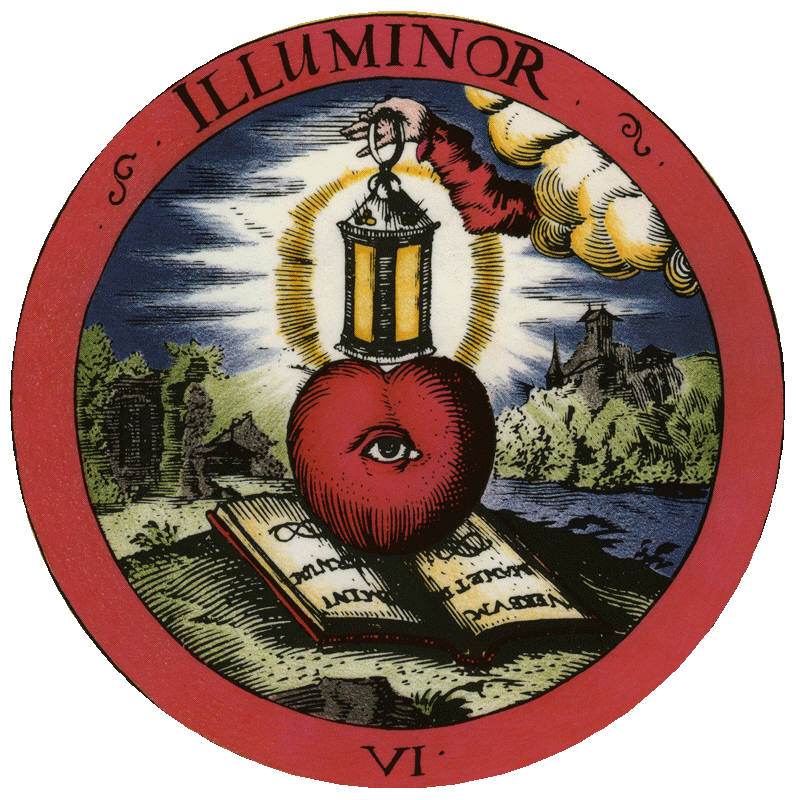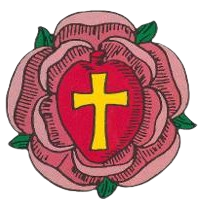History of the Brotherhood of the Rosy Cross

The Brotherhood of the Rosy Cross, or Rosicrucians, traces its founding to the year 1407 under the guidance of our beloved Father Christian Rosenkreutz and a devoted circle of disciples. This founding marks not the beginning of its sacred tradition but rather the renewal of an arcane wisdom older than the pyramids of Egypt and the sacred temples of Babylon, a wisdom carried forth from the very dawn of humanity.
The Magian Origins
Father Christian Rosenkreutz, a seeker of truth and illumination, received his initiation in the Middle East, where he was instructed by the "men of the unseen," the elders of the Magi. The Magi, known in Christian tradition as the first to recognize the Christ, were the guardians of an ancient and unbroken stream of wisdom. Surviving centuries of persecution, they veiled their sacred teachings beneath the mantle of Sufism and preserved them through quiet fidelity to the eternal truths.
From the Magi, we derive the very words image, imagination, and magic, each rooted in the “science of the Magi.” It was they who entrusted Christian Rosenkreutz with the secret traditions—wisdom older than Egypt and borne from the divine gift to Adam. This knowledge, carried by Moses, Solomon, and the prophets, had been known to Christ and imparted to His disciples as the Disciplina Arcani, the secret teaching of the Hidden Church of the Graal.
The Esoteric Mission
This esoteric wisdom was not for the many but the few—those proven in virtue and fortified by spiritual discipline. It was too sacred to be cast before the world and could only be entrusted to those worthy of its stewardship. Father Rosenkreutz, recognizing this sacred trust, returned to Europe and gathered a small band of disciples. Together, they established the Brotherhood of the Rosy Cross to safeguard and perpetuate the mysteries of the divine science.
Two centuries after its founding, the Brotherhood stepped from the shadows to issue its seminal declarations: the Fama Fraternitatis and the Confessio Fraternitatis. These manifestos revealed the Brotherhood’s mission and teachings to the world, albeit veiled in the allegorical language of Hermetic tradition. They became the cornerstone of authentic Rosicrucianism, the touchstone by which all true adherents may be known.
The Legend of Father Rosenkreutz
The Fama and Confessio tell the story of Christian Rosenkreutz, a monk in the tradition of the Knights Templar, who journeyed to the East in search of wisdom. There, he encountered the ancient Magian brotherhood and was initiated into their mysteries. Charged with carrying the torch of this sacred tradition into the West, Rosenkreutz returned to Europe and established a sanctuary for the preservation and transmission of the Hermetic arts.
This sanctuary became The Brotherhood of the Rosy Cross, dedicated to a divine mission: the restoration of the apostolic Graal Church and the reformation of the social and spiritual order. Their vision was no mere utopian fantasy but a divine alchemy—the union of Protestant and Catholic truth into the harmony of the original apostolic faith. Though the earthly paradise they envisioned has yet to be realized, the Brotherhood continues this sacred labor, working in silence and secrecy toward the restoration of humanity’s divine heritage.
Rosicrucianism and the Hidden Church
Rosicrucianism is not to be understood as a religion in the conventional sense but rather as the sacred heart of all religion. It is the esoteric teaching that lies hidden within every tradition, the secret stream of wisdom flowing beneath the surface of faith. As Willy Schrodter so aptly wrote, "Rosicrucianism is a religion, and every genuine Rosicrucian is 'a priest for ever after the order of Melchizedek' (Hebrews 5:6)."
The Brotherhood has remained ever faithful to this sacred calling. It is a luminous thread connecting the ancient Magi to the present day, a hidden light guiding humanity toward spiritual enlightenment. Those who would seek its mysteries must be prepared to tread the path of the cross and the rose—a journey of transformation, sacrifice, and divine illumination.
Thus, the Brotherhood of the Rosy Cross continues as it began: an eternal flame burning brightly in the shadow of the world, its light discernible only to those whose hearts are pure and whose spirits are awakened.
The Brotherhood of the Rosy Cross Comes to America
The origins of the Brotherhood of the Rosy Cross in the New World trace back to a remarkable figure, Johannes Kelpius, the “Hermit of the Wissahickon.” A mystic of profound vision, Kelpius led a band of esoteric seekers into the wilderness of Pennsylvania in the late 17th century. They came to the New World not for worldly conquest but to prepare for the dawning of a divine age, to live as contemplatives, and to guard the sacred mysteries of the Rosy Cross.
In the year 1694, under the providential guidance of Johannes Kelpius, a small band of forty disciples of the Brotherhood of the Rosy Cross crossed the ocean to establish their sacred order in the New World. Their voyage marked the transplantation of ancient wisdom to an untamed land, a solemn undertaking charged with spiritual significance. These pilgrims, who referred to themselves as the Chapter of Perfection, carried with them not only the mystical traditions of their order but also instruments of enlightenment, including the first telescope ever brought to America. They were the first, apart from the native inhabitants, to compose music upon the soil of this continent—a testament to their harmonious blending of celestial science and sacred art.
The Settlement at Wissahickon
Arriving near Philadelphia, they settled in a wooded glen beside the Wissahickon Creek, where their devotion to the life of contemplation and spiritual labor soon earned them the name "Monks of the Ridge" or "Monks of the Wissahickon." Others, inspired by their nightly vigils under the stars, referred to them as the "Woman in the Wilderness," a name drawn from the apocalyptic vision in the Book of Revelation. Each evening, these brethren gathered to observe the heavens, their eyes fixed upon the mysteries of the cosmos, watching for holy signs that would herald the return of their Lord.
Their arrival in America was marked by an auspicious concurrence with St. John’s Eve, the midsummer night of the Rosicrucian calendar, revered as a holy feast. Thereafter, this night became a cornerstone of their observances, celebrated each year with solemn rites and prayers. Legend holds that upon St. John’s Eve of 1701, the brethren beheld a miraculous vision: “a white, obscure moving body in the air, which, as it approached, assumed the form and mien of an angel … it receded into the shadows of the forest and appeared again immediately before them as the fairest of the lovely.” Such occurrences were woven into the fabric of their mystical life, reinforcing the divine sanction of their mission.
The Tabernacle of Light
Near their humble monastery, the brethren erected a sacred Tabernacle, upon which they placed the emblem of their order: a cross within a heart or circle. Ingeniously positioned, this symbol of the Rosy Cross was struck each morning by the first rays of the rising sun, transforming it into a radiant beacon of rose-hued light. This daily illumination symbolized the inner awakening of the soul, the union of divine wisdom and human striving, and the perpetual renewal of the spiritual life.
Mysteries and Legacies
The life of the Wissahickon brethren was shrouded in legend. Tales of their nightly vigils, alchemical experiments, and the casting of horoscopes have persisted through the centuries, lending an air of mystery to their endeavors. Johannes Kelpius himself, the spiritual leader of the group, is said to have dwelt in a stone sanctum carved into the hillside along the Wissahickon. This cave, still extant and visited by pilgrims to this day, served as both his cell of meditation and a locus of esoteric work.
Upon his passing, Kelpius instructed one of his disciples to cast a box containing his most precious magical artifacts into the Schuylkill River. Legend whispers that among these treasures was the Philosopher’s Stone itself, its power now diffused into the waters, waiting for the worthy to rediscover its secrets.
The Successors of Kelpius
After Kelpius’s death, his mantle was taken up by Conrad Matthai, a mystic of extraordinary gifts. Under his leadership, an inner circle of six adepts remained, continuing the sacred work even as many of Kelpius’s disciples dispersed to spread their teachings. These six became a hidden presence in the region, known to locals by the rare and fleeting sight of their hooded figures walking single-file along forest paths. On certain nights, when the stars align in their ancient patterns, some claim that the ghostly forms of these adepts may still be seen gliding silently along Forbidden Drive in the moonlight.
Matthai himself was renowned for his psychic powers and profound spiritual abilities. A healer and prophet, he could exorcise demons, project his astral body to distant lands, and return with knowledge no ordinary means of communication could convey. Before the advent of the telegraph, Matthai’s powers made him a messenger beyond the limitations of time and space.
An Enduring Mission
The coming of the Brotherhood of the Rosy Cross to America was not merely the establishment of a community but the planting of a spiritual seed in the fertile soil of a new land. Their lives of discipline, devotion, and divine aspiration serve as a luminous example of the Rosicrucian ideal: a perpetual quest for wisdom, the harmonization of the human with the divine, and the quiet labor of preparing the soul for its eternal destiny.
Through their sacred observances and their enduring legends, the Monks of the Wissahickon remain a vital thread in the rich tapestry of Rosicrucian tradition, their light undimmed by the passage of centuries. They stand as a testament to the eternal truth that the rose blossoms best upon the cross of sacrifice.
The Disciples Who Wandered
Following the example of Christ’s Apostles, many of Kelpius’s disciples became itinerant teachers, wandering far and wide as "men of the unseen," seeking souls worthy of initiation into the mysteries of the Rosy Cross. In their journeys, they left indelible marks on the spiritual landscape of America.
The Shakers, led by Mother Ann Lee, counted secret Rosicrucians among their followers, and the Brotherhood’s influence can be discerned in their mystical practices. Likewise, the Ephrata Cloister, founded by Conrad Beissel, served as the outer court to an inner Rosicrucian order. Beissel himself, having come to America to join Kelpius, was steeped in the alchemical and mystical teachings of the Brotherhood.
The Harmonists and New Harmony
Perhaps the most profound legacy of the Rosicrucians in America lies with George Rapp and the Harmonists. Father Rapp, an alchemist and mystic, was a Rosicrucian adept whose teachings transformed his community into a manifestation of Rosicrucian ideals. Upon his death, a half-million dollars of pure gold, the fruit of alchemical labor, was discovered in a vault near his laboratory, a place that may still be visited today.
The Harmonist settlement of New Harmony, Indiana, became another nexus of Rosicrucian influence. Sold to Robert Owen and his circle of scientists and reformers, the settlement became a crucible for the dissemination of esoteric knowledge. While true Rosicrucians remain ever silent regarding their affiliations, the spirit of the Rosy Cross undeniably shaped Owen’s vision. His eventual embrace of Spiritualism, an outgrowth of Rosicrucian teachings, further cemented this connection. His son, Robert Dale Owen, carried on this legacy as an early paranormal investigator and Spiritualist author, his book Footfalls on the Boundary of Another World bridging the veil between the material and the unseen.
The Eternal Work
The Brotherhood of the Rosy Cross has never ceased its mission. Though it moves in silence and secrecy, its influence is felt wherever seekers yearn for the hidden truths of life. Its adepts, veiled under the sacred rose, continue to guard and transmit the Mysteries, ensuring that the flame of the Rosy Cross remains ever alight, illuminating the path for those with eyes to see and hearts to understand.

